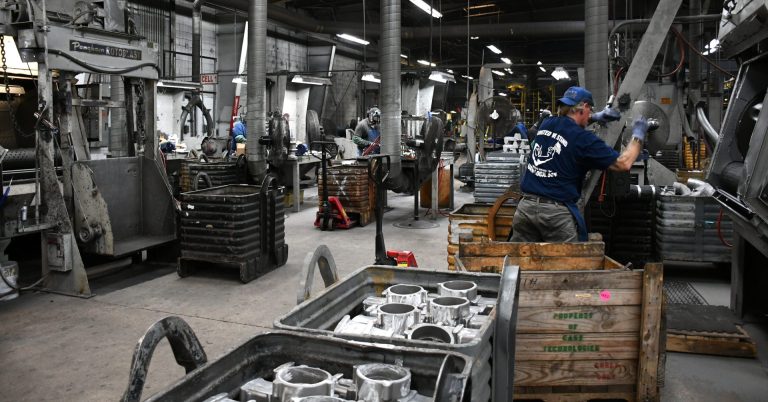Attaining Quality in Aluminum Casting: Expert Tips and Techniques
Attaining Quality in Aluminum Casting: Expert Tips and Techniques
Blog Article
Study the World of Aluminum Spreading: Recognizing the Various Techniques
Light weight aluminum spreading is an essential process in the production sector, with different approaches employed to develop precise and complex components. From the standard sand spreading method to the sophisticated die spreading process, each method offers distinct benefits depending on the requirements of the job.
Sand Spreading Approach
Sand casting, a widely-used technique in aluminum casting processes, involves creating mold and mildews made of compressed sand for putting liquified metal. When the mold is ready, it is firmly positioned in a flask and molten light weight aluminum is put into the dental caries.
After the metal has actually cooled down and strengthened, the sand mold is broken away to disclose the light weight aluminum spreading. Sand casting allows for the manufacturing of intricate forms and big parts that might be hard or pricey to produce making use of various other techniques. It is also a lasting strategy as the sand can be recycled and used numerous times, minimizing waste in the casting procedure.
Long-term Mold Strategy

One substantial benefit of the Irreversible Mold And Mildew Strategy is the enhanced dimensional precision it uses. The steel mold enables for tighter tolerances and finer information in the last light weight aluminum spreadings contrasted to sand casting methods. This precision makes it a preferred selection for applications where limited dimensional control is crucial, such as in the aerospace and automotive sectors.

Die Casting Refine

Financial Investment Casting Strategy
Making use of an accuracy spreading technique, Investment Casting Method involves creating intricate light weight aluminum parts by putting molten metal into a ceramic mold and mildew. This procedure, likewise understood as lost-wax casting, starts with the production of a wax pattern of the preferred part. This wax pattern is then covered with a ceramic product to develop a shell. As soon as the ceramic covering is solidified, it is heated to get rid of the wax, leaving a hollow ceramic mold.
The following step involves putting the molten aluminum into the ceramic mold. The light weight aluminum fills up the cavity left by the wax pattern, taking its form precisely. This approach is favored for its capacity to create intricate shapes with high precision and a smooth surface coating. Investment spreading is typically made use of for producing parts in markets where intricate styles and limited tolerances are needed, such as aerospace, auto, and medical tools. The adaptability click reference and accuracy of the Investment Casting Technique make it a valuable method on the planet of aluminum spreading.
Lost Foam Casting Approach
Having actually discovered the intricate precision of Investment Casting Technique, the emphasis currently shifts to the innovative method of Lost Foam Spreading in light weight aluminum part production. Lost Foam Casting, also called evaporative pattern casting, is a modern method where a foam pattern of the preferred component is produced and afterwards coated with a refractory product. The layered foam pattern is after that hidden in sand, and molten light weight aluminum is put right into the mold and mildew. As the metal fills up the mold, the foam evaporates because of the warm, leaving a clean tooth cavity in the shape of the desired part.
Among the primary advantages of Lost Foam Spreading is its capacity to create complicated shapes with detailed information, usually in a solitary piece without the need for added machining. This technique is likewise known for its high dimensional precision and smooth surface finish. In Addition, Lost Foam Casting is an economical process as it reduces the demand for cores and permits the manufacturing of light-weight components. Regardless of its benefits, get redirected here Lost Foam Casting calls for cautious control of the casting process to avoid defects and ensure high quality components.
Verdict
To conclude, light weight aluminum spreading provides a range of methods such as sand casting, long-term mold and mildew strategy, pass away casting, financial investment spreading, and shed foam casting. Each technique has its very own benefits and applications, making aluminum casting a flexible and commonly made use of process in different markets. Recognizing the differences between these approaches is essential in choosing one of the most appropriate casting strategy for particular manufacturing requirements.
Sand casting, a widely-used technique in light weight aluminum spreading procedures, entails creating molds made of compacted sand for pouring molten metal. aluminum casting.The Long-term Mold And Mildew Method, like sand spreading, is an additional widespread approach used in light weight aluminum spreading procedures, supplying distinctive benefits in terms of mold and mildew reusability and dimensional precision. The steel mold and mildew enables for tighter resistances and better details in the final aluminum castings contrasted to sand spreading approaches. The 2 major kinds of die casting are chilly chamber die casting and warm chamber pass away casting, each ideal for different kinds of light weight aluminum alloys.In verdict, light weight aluminum spreading supplies a variety of techniques such as sand casting, long-term mold method, pass away casting, financial investment spreading, and lost foam spreading
Report this page